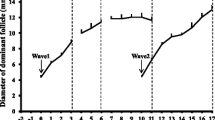Abstract
The ultrastructure of bovine morulae and blastocysts developed from in vitro-matured and -fertilized oocytes in a serum-supplemented medium was compared with that of morulae and blastocysts collected non-surgically from superovulated cows. In the in vivo-derived morulae, two characteristic cells types could be identified by the electron-density of their cytoplasm and by their ultrastructural features. One type appeared light in color with low electron-dense cytoplasm. These cells were located in the peripheral layer of the cluster of blastomeres, possessed numerous cellular organelles such as mitochondria and Golgi apparatus and had microvilli projecting into the perivitelline space. The other cell type was distinguished by cytoplasm that stained more densely than that of the lighter-appearing cells. The darker-appearing cells generally possessed fewer organelles than the lighter cells, but many lysosome-like structures were present in the cytoplasm. The in vitro-developed morulae also contained two types of cells similar to those observed in the in vivo morulae. However, most of the in vitro-developed cells possessed numerous lipid droplets and contained fewer lysosome-like structures than the cells of the in vivo-derived morulae. The blastocysts, both in vivo and in vitro, showed a clear differentiation of trophoblast cells and inner cell mass (ICM)-cells. In the in vivo-derived blastocyst, the apical membrane of trophoblast cells was covered with large, numerous microvilli and well-developed junctional complexes were observed. Lipid droplets were present in the cytoplasm of trophoblast and ICM-cells but were not abundant. In vitro-developed blastocysts showed less well-developed junctional complexes between trophoblast cells, less well-developed apical microvilli on the trophoblast cells, and contained large numbers of lipid droplets. This accumulation of lipid droplets was higher in the trophoblast cells than in the ICM-cells. The zonae pellucidae of in vitro-developed embryos were thinner than that of the in vivo-derived embryos. This study demonstrates conspicuous differences in the ultrastructural features between the in vivo-derived and in vitro-developed embryos, suggesting that the ultrastructure may reflect the various physiological anomalies observed in previous studies.
Similar content being viewed by others
Author information
Authors and Affiliations
Additional information
Accepted: 29 October 1998
Rights and permissions
About this article
Cite this article
Abe, H., Otoi, T., Tachikawa, S. et al. Fine structure of bovine morulae and blastocysts in vivo and in vitro. Anat Embryol 199, 519–527 (1999). https://doi.org/10.1007/s004290050249
Issue Date:
DOI: https://doi.org/10.1007/s004290050249




